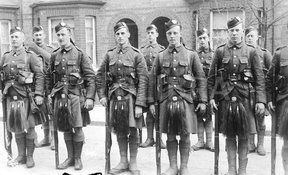WHO WAS SYDNEY HAGUE?
- alfieisnotmydog

- Jun 12, 2016
- 3 min read
Sydney Hague (1891-1968)
Sydney was born to John and Mary Hague in 1891, the eldest of 2 children although his younger brother died of influenza in infancy. His family came from Oldham and his father was a Foreman in a tool-making factory according to the 1911 census.
Sydney won a scholarship to Manchester Grammar school and then a scholarship to study Engineering at Manchester University where he secured a 1st Class Honours degree in July 1913. He was a very talented sportsman and family folklore suggests he played for Oldham Athletic (the “Latics”) in a pre-war season although I cannot find any record of this.
In the year following graduation, Sydney moved to London to work for the India Iron Company. When war broke out he joined up, not to a local Lancashire Regiment but one of the main Territorial Force regiments, the 1st Battalion 14th Regiment of the London Scottish. This regiment typically recruited men that were Scottish or of Scottish decent, or where men paid to join.
We do not know about his motivations, but his regiment number, No.3113 suggests he joined up between 1st September 1914 and 5th November 1914 – so possibly the failure of the Schlieffen Plan in early September 1914 might have been a trigger.
The 1/14th was the first Territorial regiment to fight against the Germans as Messines Ridge. They were also involved in the 1st Ypres Battle. Although I have no record to confirm this I like to think, because of his Latics connection, that he was one of the soldiers that played football during the December 1914 Christmas Armistice.
We have Sydney’s original identity tag (that shows his regiment and number) on the original string and also his cap badge.

We have no photographs that show his uniform but at this time he might have worn a kilt and looked like the soldier below.

Although he was a graduate, records from the Forces Archives show that Sydney entered the regiment as a Private. His regiment was involved in the Battle of Loos in the summer of 1915 where he was injured (shrapnel wound to lower leg) and invalided home first to Royal Victoria Hospital at Netley in Hampshire and then to Conwy in North Wales to convalesce. Here he married Doris Mackenzie (a student from Manchester University) when he was at home. We have photo of them with a friend:

He was also Mentioned in Dispatches (MID) – I cannot find any record of what he did but we have a gold fern emblem to show this:

When he returned to active service it seems that 2 things happened – firstly his Forces Record indicate he was transferred to the Royal Engineers and also that he received a temporary commission. The London Gazette in January 1916 lists Sydney as one of a number of men given a second lieutenant rank (probation)

I have not been able to find any detailed records of what Sydney did for the remainder of the Great War but his regiment was involved in the Somme Battle, probably involved in the digging of frontline trenches and possibly even some of the tunnels. He also fought in the battle of Cambrai, the first time tanks were used in significant numbers.
He survived the Great War and received the standard medals given to most WW1 survivors

1. Dog Tag
2. 1914-1915 Star (Pip)
3. British War Medal (Squeak)
4. Victory Medal (Wilfred)
5. Royal Ordnance Corps Cap Badge
6. Miniature Medals for Dress Kit
7. 14th London Scottish Cap Badge (WW1)
8. Loyal Service Badge (WW2)
9. Royal Army Pay Corps Cap Badge (WW2)
Sydney Hague stayed in the Territorial Force during the inter-war period and was therefore called up at the start of WW2 when at the age 48 he was commissioned as a Major in the RAMAC. Unfortunately he was captured just outside Poperinge on BEF retreat to Dunkirk and spent the rest of the war in a series of Officer Prison of War camps including one with Douglas Bader. We have a diary of his time spent in captivity…..but that is another story!



Comments